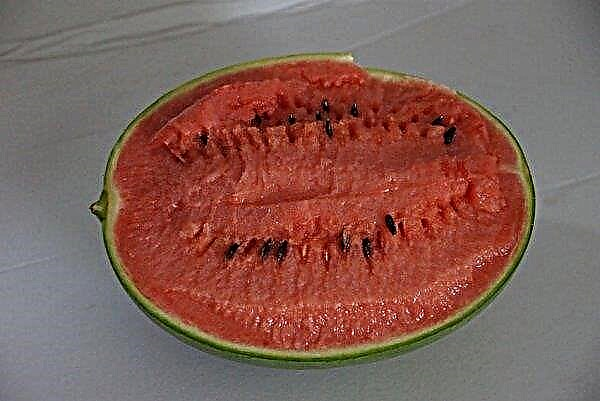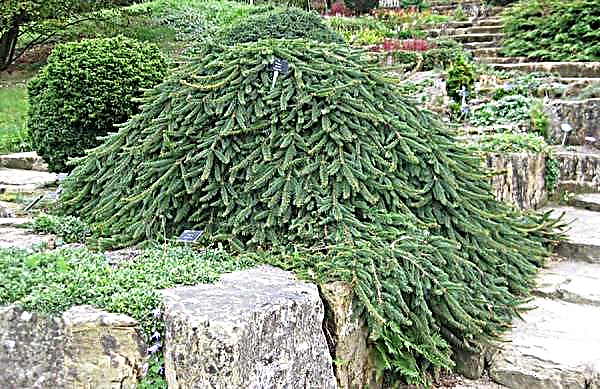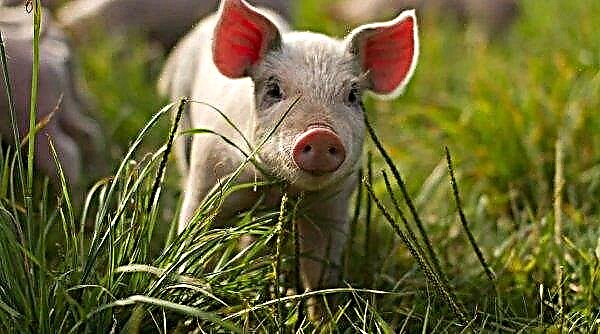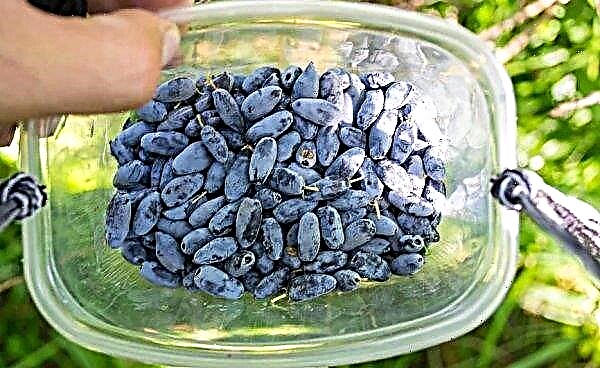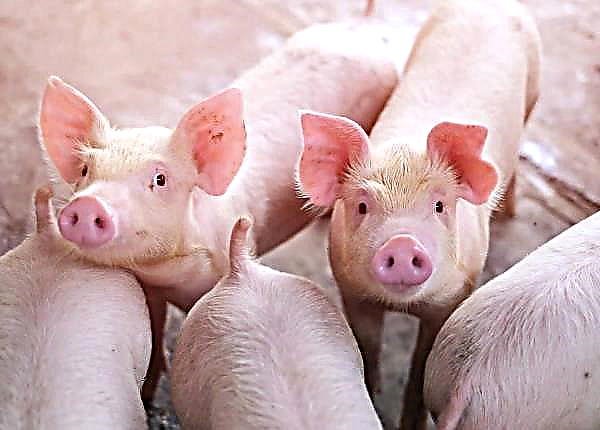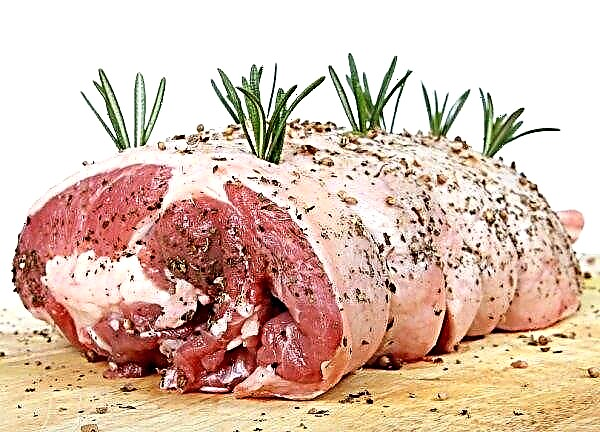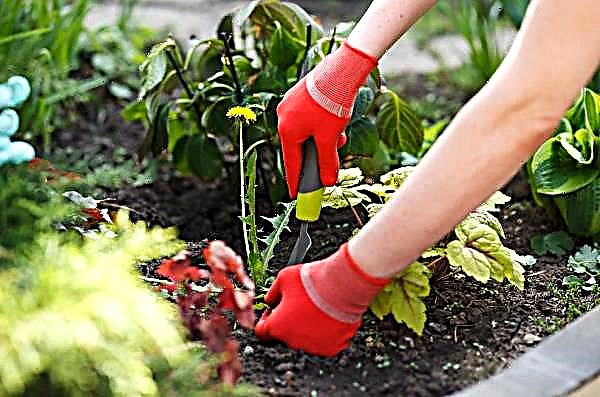Almost every owner of a suburban area wants to have a beautiful lawn. A lawn with even green grass can be not only a decoration of the territory, but also act as a resting place for all family members. To grow a beautiful well-groomed lawn with your own hands is not an easy task. In order for the venture to succeed, it is necessary to properly prepare the land, to know how, when and what seeds to sow, as well as to properly care for the lawn lawn throughout the entire time.
When to sow lawn grass
The most favorable conditions for the germination of sown seeds are the absence of heat and moderately moist soil. Before sowing the lawn, you should familiarize yourself with the weather forecast for the next 10 days. If frost is expected or vice versa a hot season, then you should not start sowing. The most optimal time in the middle latitudes is spring (April-May) and autumn (end of August - September).
In each region, it is necessary to independently determine the sowing time. The north is the site, the shorter the period between cold weather, but there is a rainy cool summer. After sowing, the first seedlings will appear no earlier than after 14 days. In cool weather, this period may increase. The lawn will fully germinate only after 3 months.
Important! If you decide to use rolled lawns, then they can be laid at any time of the year under any conditions. Grass in rolls is adapted to temperature changes.
Choosing the type of lawn and grass
According to the method of laying, the lawns are divided into those that are seeded from seeds, and rolled. At the same time, lawns planted with seeds have a low cost compared to rolled ones. However, lawn grass requires a large number of preparations before sowing, time for germination and careful care throughout the entire time of existence.
A rolled lawn allows you to get the perfect grass carpet instantly, while it practically does not require additional care, except for watering. However, the laying of such rolls is often only possible for specialists, which brings additional costs. When purchasing a rolled lawn, you should inspect it. The grass should not crumble when deployed, its roots should be alive and moist. In addition, after the acquisition, the rolls must be stacked within 48 hours, otherwise the grass in them dies.
There are several types of garden lawns:
- Ground floor (ceremonial) - has an exclusively decorative purpose. These lawns look perfect, the grass spreads in emerald velvet. This decoration certainly enhances the prestige of the owners in the eyes of others. However, it is worth remembering that the front lawn does not tolerate absolutely no load, it is forbidden to walk on it not only to people, but even animals. Such lawns are created in the front gardens, near the main flower beds, on the sides of the main entrance to the house. They emphasize the most profitable and beautiful objects on the site. The area of the ground grass must certainly be larger than the area of the object that the owner wants to allocate. They create such "green carpets" from a mixture of elite herbs, for which they take bluegrass, ryegrass, red fescue, timothy.

- Ordinary. It has a very beautiful view, which also allows you to significantly decorate the summer cottage. It does not require particularly complicated care. Such a lawn is resistant to impacts, however, with excessive loads it loses its appearance. The grass here is universal, unpretentious, has a beautiful emerald shade, seeds are affordable. Ordinary lawn is sown, mainly using field comb and field grass, bluegrass and fescue.
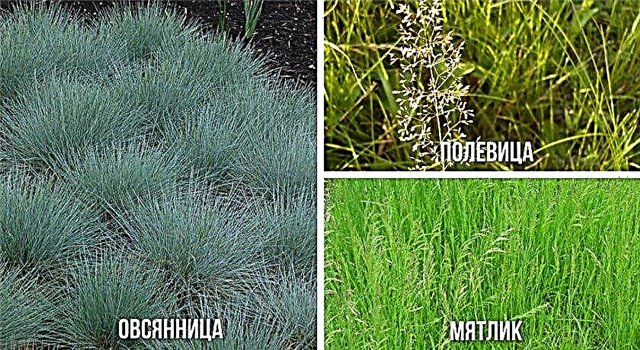
- Super hardy (sports) is a special type of living coating that is able to maintain its properties even with very strong long-term loads. These lawns are used on golf courses, sports and games. Moreover, there are mixtures for each sport and loads separately (tennis, football, golf, a playground for children) and all of them are very resistant to stress. Such coatings are very demanding to care (drainage, watering), they are rarely seen in a private yard. The seed rate for such lawns is one and a half to two times more than usual. The composition of the mixture includes: ryegrass, field grass, meadow fescue. The cost of such a "carpet" is very high.

- Mauritanian (blooming) - the most striking and decorative. Such a lawn is created when using not just herbs, but also other plants that have natural decorativeness (ground cover) or beautiful flowers. It is not difficult to drop him off; leaving is also simple. Lawns of this type perfectly complement all kinds of landscape compositions, in addition, butterflies and buzzing bees always flutter on them. The seed mixture consists of traditional lawn grasses, where poppy seeds, clover, forget-me-nots, daisies, bluebells and other meadow flowers are mixed.

- Shade tolerant - a lawn capable of maintaining decorativeness in shade conditions. This coating helps the owners when they need to give an attractive look to one of the problem areas (for example, under trees). The herbs that are chosen for this (periwinkle, tenacity, selection cereals, groundcover, mosses) have a special resistance to the absence of sunlight, are not demanding to care, and grow very quickly.

Did you know? In the United States, when selling a home, the presence of a manicured lawn increases its value by almost a quarter.
Layout and calculation of the required number of seeds
On the factory packaging with herbal mixtures, the rate of seed consumption per 1 m² is always indicated. However, gardeners often sow more seeds. This is due to the desire to get a guaranteed beautiful thick lawn. Indeed, if there is not enough seed or if not all grass sprouts equally successfully, weed will grow in place of the formed “bald spots”, and the entire procedure for growing the coating will have to be repeated from the very beginning. At the same time, even when sowing manually, it does not take much effort and time.
Sowing time is also of great importance. In the autumn period, you can sow grass according to the instructions, it is most likely to grow well. In the spring-summer period, usually one and a half times more seeds are taken than indicated in the description. This is because in spring, when ice and snow melt with a stream of water, part of the seed is washed off the site or gets too deep into the ground.
In the summer, increasing the seed rate, they try to insure themselves against excessive heat, which has an extremely negative effect on seedlings. In addition, on uneven areas, hills, slopes, the seed consumption rate also increases to achieve a visually even, uniform coating of grass.Important! Seeds located above the rest of the soil are always noticeably washed out during irrigation and rainfall, sliding down.

Site and soil preparation
Before starting the preparatory work, it is necessary to determine the place where the lawn will be broken. It is also worth considering in advance what type of grass will be sown. It depends mainly on the presence of sunlight on the site, as well as on the purpose of the lawn. It is desirable that the site is sunny, without stagnation of groundwater. This will greatly simplify work in the future.
All necessary equipment should be prepared in advance. To work on the site using:
- rake;
- pitchfork;
- a shovel;
- string;
- water level;
- stakes;
- cars;
- a small skating rink.
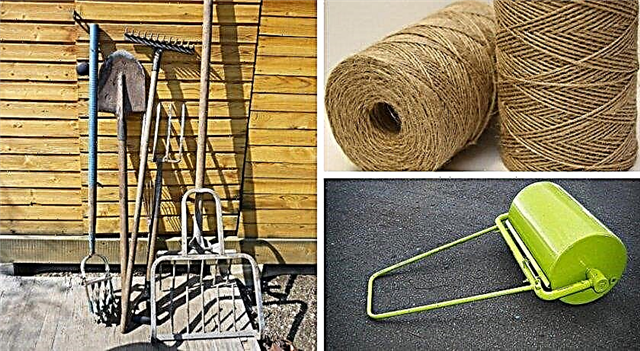
Tillage
The most suitable time for preparing the soil for the lawn is the second half of April - the first days of May. At this time, the weather is already quite warm, and the land has not yet dried up. Site preparation time is on average from one week to a month, depending on the volume and complexity of the tasks.
The selected area must be freed from stones and excess objects. Dig the soil in depth by 30 cm. In this case, the quality of the soil should be determined. If it is not fertile enough, humus is added to it (3 kg per 1 m²). If the soil is very heavy, it is mixed with sand, if sandy, clay admixtures are added. During digging, weeds are also disposed of. With proper preparation, you will be spared from frequent weeding in the future.
During digging, weeds are also disposed of. With proper preparation, you will be spared from frequent weeding in the future.
You should also mark the lawn, where the locations of future flower beds, paths and other components of landscape design will be marked. Marking is usually carried out with the help of stakes and rope. It is worth remembering that clear forms with strictly limited angles do not look advantageous in all cases. If the lawn implies the presence of flowering compositions or groundcover, then in this case it will acquire an aesthetic appearance, having smooth outlines.
Did you know? Since ancient times, in Norway, Germany and other Scandinavian countries people have been growing grass on the roofs of houses. This coating serves as a natural defense to the owners and looks like a lawn.
In May, herbicides have a greater effect on plants than at other times of the year. After weeds die, they should be mechanically removed from the site using a rake and a shovel. If you want to permanently get rid of the germination of former weeds, and if the quality of the soil leaves much to be desired, the entire area under the lawn can be covered with geotextiles, through which they will not grow. Fertile soil mix is laid on geotextiles.
 Further, the territory should be treated with herbicides with a common effect, which will eliminate the undesirable presence of weeds.
Further, the territory should be treated with herbicides with a common effect, which will eliminate the undesirable presence of weeds.
Attention should be paid to qualitatively preparing the site for sowing. This is an important step in the construction of lawn cover.
Installation of drainage systems
If the site is located in a lowland, groundwater lies close to the surface, during rainfall and irrigation, water stagnates - a drainage system should be created. These works are carried out in parallel with the soil leveling process. Drainage serves to eliminate excess water, maintain air-water balance in the soil.
The drainage system can be arranged in various ways:
- The upper fertile soil layer with a thickness of 15–20 cm is removed. Crushed stone, expanded clay or pebble is laid with a uniform layer along the entire perimeter with a layer of 12 cm. Sand (10–15 cm layer) is poured over the first drainage layer, it is also leveled and compacted. On top of the drainage, a previously removed layer of fertile soil is placed, which also needs to be leveled and compacted.
- Under the lawn construct drainage recesses. The number of such holes corresponds to the size of the plot. Dig them with a shovel. The shape of the hole is cubic, dimensions 60 × 60 × 60 cm. Broken bricks or small pebbles with a layer 40 cm high are placed at the bottom of each cavity. Sandstone is covered with a layer of 10 cm on top of the stone, and then fertile soil (10 cm layer).
- Specialists are invited to mount the drainage system in the form of pipes.
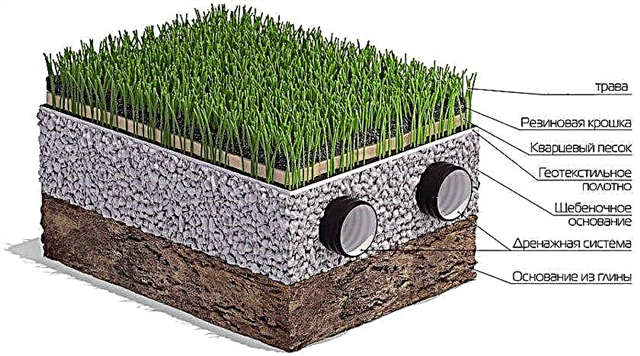
Surface alignment
After tillage and the construction of a drainage system, the site must be thoroughly leveled, breaking up large earthen clods. If the area of the lawn is small, then you can cope with this task manually using a rake and shovels. If the area under the grass cover is impressive, then you should resort to using a walk-behind tractor or a cultivator.
The treated soil should consist of lumps, not more than 5 mm in diameter. After cultivation, the surface of the earth is leveled using a board that is dragged along the site, which eliminates the remaining depressions and bumps.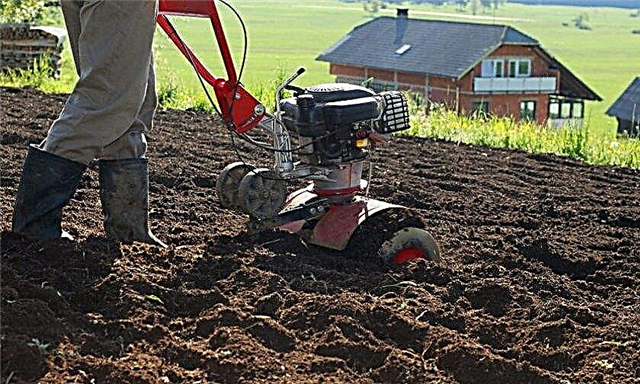
Fertilizer and ramming
When digging the soil, if necessary, peat (4 kg per 1 m²), compost (3 kg per 1 m²) or vermicompost (according to the instructions), and hydrated lime (if the soil is acidic) are added. At the same time, mineral substances are added to the soil, according to the instructions on the grass mixtures.
At the same time, during spring sowing, emphasis is placed on nitrogen-containing fertilizers (ammonium sulfate, ammonium nitrate, nitroammophoska) so that the greens grow quickly and luxuriantly. In the autumn, potassium and phosphoric (superphosphate, potassium chloride, potassium sulfate) preparations are added to strengthen the root system and general immunity of plants.

For two or three days before sowing the grass, it is necessary to water the area abundantly so that the earth is moistened to a depth of at least 7 cm. Thus, the soil is enriched with useful trace elements and prepared for sowing.
Before the very sowing of the grass, you should ram the soil. To do this, use a hand roller, which has a weight of about 150 kg. If there is no skating rink, and there is no place to borrow, you can tamp the ground using a large board or ski. The ramming at the same time occurs due to the person’s own weight.Important! Tamping is exclusively dry land in dry weather. After the soil is compacted, it is not worth walking on it. If absolutely necessary, you can cross such a section with skis or boards tied to your legs.

Sowing process
Sow the lawn in dry, calm weather. Grass should be sown evenly so that in the end there are no empty or too thickened places.
Sowing is carried out as follows:
- The easiest and surest way is to use a seeder. In this case, the mechanism itself will evenly distribute the seeds throughout the plot.
- In order to distribute the herb mixture manually, it must be mixed with dry fine sand in a ratio of 1: 1.
- A mixture of seeds is scattered first in the direction along the lawn, and then across.
- If the site is too large, then it is mentally divided into identical parts. In this case, the prepared grass mixture is divided into the same number of parts. Sowing is also done first along, then across, while each time blocking about 7 cm of the neighboring plot.
- Seeds need to be planted in moist, loose soil. If it is too dry, watering is necessary.
- After the seeds are sown, they need to be planted into the ground with the help of a fan (French) rake into the depth of about 1 cm.
- After that, you need to walk around the site with a hand skating rink, or trample on skis.
- At the end of the process, the plot is watered using a spray nozzle in order to moderately moisten the soil and not wash the seeds.

Further lawn care
During seed germination and subsequent active growth of herbs, they require careful regular care. A young lawn should be regularly watered, the weeds that appear and mowed. Before the first cutting procedure, you can’t walk on the young grass, even if it belongs to special resistant varieties.
Watering is carried out using sprayers, because the roots of young plants are easily damaged by a strong stream of water. The soil should be saturated with moisture no less than 7 cm where the roots of the grass are. Before emergence, the plot is irrigated daily, with the appearance of shoots (approximately 14 days after sowing), watering is reduced to once a week.
When the young grass reaches a height of 7–10 cm (depending on the variety), it needs to be trimmed. The lawn mower should be as light as possible to maintain a layer of young turf. In the future, haircuts are produced regularly throughout the season. The more often the grass is cut, the thicker and more actively it grows. A lawn is considered to be mature 2-3 years of age, its coating is thick and uniform.
Throughout the entire period of existence, the grass cover must be fertilized regularly, combed out after melting snow, cut, weed and water.The strong roots of the adult grass form a continuous weave and do not allow weeds to sprout, whose seeds can easily be brought by wind, animals, people.To grow a lawn manually is quite difficult and troublesome. However, with proper sowing and care, you can get a luxurious decoration of a summer cottage, which will delight the owners and serve as an object of admiration for the neighbors.






